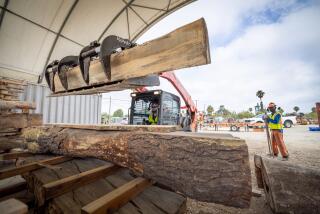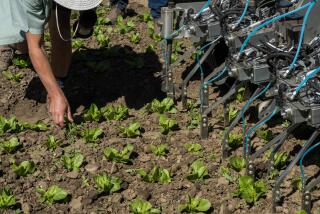Mechanized Timber Harvesting Is a Growth Industry in the Northwest
SCOTTS VALLEY, Ore. — It was bound to happen.
At a time when industries are constantly changing due to new technology, it was only a matter of time before innovation caught up with loggers. And it has.
On a rainy day in November, logging executives from around the state gathered in a second-growth grove east of Yoncalla to check out the newest tools in the tree-cutting industry.
They came to see a tandem of mechanized logging vehicles that, according to spokesmen, allow two workers to do the job of eight or more, minimize environmental damage and increase workplace safety.
“This is the future of logging,” said Rex Storm, forest policy analyst for Associated Oregon Loggers Inc. “Everybody realizes that technology is changing this profession.”
The first mechanized harvesters arrived in the Northwest in 1989, he said. Today, about 30 logging operations in Oregon, including Roseburg-based Lone Rock Timber Co., use the machines, he said.
At a time when many second-growth timber stands are in need of thinning, timber operators say the automated method, developed in Europe, makes economic sense.
Previously, many younger logs would have been left on the ground. Now most of them, down to diameters of 3 inches, can be recovered and sold.
Storm said some job losses have resulted from the advent of mechanized harvesting, but not many. Much of the work being done by the machines wouldn’t have occurred at all five years ago, he said.
“This is not a panacea to replace all logging,” he said. “It’s not eliminating traditional methods; it’s adding to what we can do.”
He said larger trees, especially those bigger than 24 inches in diameter, are too heavy for current mechanized harvesters and still require conventional logging.
*
From the outside, the logging machines look like something out of science fiction. The all-terrain, diesel-powered behemoths stand more than 15 feet high; plexiglass- and steel-encased cockpits boast twin joysticks, pedals, gauges, control panels and a computer touch pad.
Operators maneuver the machines, which can weigh 12 tons or more, around obstacles and into stands of trees, where one machine saws trees, sets them down, shaves off branches and then cuts them to prescribed lengths. The other loads the logs into a trailer and ferries them to a loading area.
The idea might not sound revolutionary, Storm said, until you consider what had been the practice in the past.
After trees crashed to the ground, they would have been dragged from the forest, likely tearing up the soil, and then their branches would have been burned in a slash pile. But mechanized loggers lift and carry logs, leaving nutrient-rich limbs and needles behind.
Those branches also give the machines a surface to drive on, which allows them to steer through the forest with less impact on the ground. And, because they can venture deep into groves to recover logs, the machines have reduced the number of logging roads, Storm said.
“It’s light on the terrain--that’s important,” said Gary Betts, owner of More Logs Inc. in Sweet Home, who has been using mechanized equipment since 1992. “We can improve a stand and do less damage than ever before, and still increase the volume of wood we recover by 20%.”
Betts said private landowners are seeking out companies that use mechanized harvesters. “Two years ago I was knocking on doors trying find jobs,” he said. “Now people are calling me.”
However, the arrival of the mechanized harvesting era in the Northwest has brought with it a need for technologically savvy loggers, who have been difficult to find, Betts said.
“People tell college-educated kids that there’s no future in logging,” he said. “That’s just not true. This will be a big part of it.”
*
Because one operator is being asked to do the job of many and be ecologically sensitive, it increases the skills he or she must have, Storm said. That includes familiarity with forestry practices and soil types, hand-eye coordination and familiarity with computers, plus a basic understanding of mechanics, hydraulics and, of course, chain saws.
In addition to the added training needed to operate mechanized harvesters, the investment costs can be staggering. The price tag is near $750,000 for the tandem of harvester, which cuts the logs, and forwarder, which removes them.
Part of those expenses can be offset by lower labor costs, Betts said, but operations also need to maintain a steady flow of jobs to pay the bills.
“It’s been a dramatic change, but we needed to make it,” he said. “Companies that aren’t adapting are going under.”
“This method is allowing landowners to see a greater recovery in value from their stands,” Storm said. “Based on that fact alone, it’s only going to grow.”
More to Read
Sign up for Essential California
The most important California stories and recommendations in your inbox every morning.
You may occasionally receive promotional content from the Los Angeles Times.










